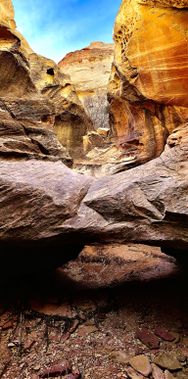Wingate Wander
| Rating: | |||||||||||||||||||||||||||||||
|---|---|---|---|---|---|---|---|---|---|---|---|---|---|---|---|---|---|---|---|---|---|---|---|---|---|---|---|---|---|---|---|
| | Difficulty:4B IV (v4a2 IV) Raps:3 +, max ↨190ft
Red Tape:Permit required Shuttle:None Vehicle:4WD Rock type:Sandstone | ||||||||||||||||||||||||||||||
| Start: | |||||||||||||||||||||||||||||||
| Parking: | |||||||||||||||||||||||||||||||
| Shuttle: | |||||||||||||||||||||||||||||||
| Condition Reports: | |||||||||||||||||||||||||||||||
| Best season: | FALL
|
||||||||||||||||||||||||||||||
| Regions: | |||||||||||||||||||||||||||||||
Introduction[edit]
A Beautiful route that combine 2 short Canyons with an astonishing landscape. Depending on your skills you can complete it as 3(A/B)III by using standard anchors and the bypasses described in the beta, or 4(A/B)IV if you use sandtrap/wateranchor and ghosting technics to complete the canyon without taking the bypasses.
Approach[edit]
Approach for the first canyon It starts by the parking lot at Pleasant Creek close by Capitol Reef Field Station. You will be hiking parallel to Pleasant creek for about 20 min. later you will be turning to the RDC, and you will be starting to scramble up to the drainage of the first canyon for about 1.5-2 hours with and average pace.
Note: For more information about the Approach please visit http://www.bluugnome.com
Descent[edit]
One you are on top of the first canyon (38.17549 -111.17427), find your way down through the boulders to the base of the canyon. You will be bushwhacking before you arrive to the first downclimb section, and later on you will be arriving to the first rappel station (38.17437 -111.17315). This first part can be completed in less that one hour.
After the first technical section is completed, you need to start hiking up LDC for about 30 min until you find the deep crack that is the reference point for the anchor of the first rappel for the second canyon.
The first rappel of the second canyon is located about 150ft at the right side of the deep crack. Originally the 140ft rappel is done from a set of bushes. However, the bushes looks dead. The new anchor is located about 30ft close to the old anchor.
We place a 25ft courtesy rigging from the big tree located at the beginning of the drainage. For that reason the rappel will be increased up to 190ft from the tree (or 165ft from the courtesy rigging while it is full extended to the V shape of the crack).
The deadman anchor of the 2nd rappel of the second canyon is gone. The new anchor is a chockstone with a webbing located at the bottom of the downclimb section. The small pothole doesn't have enough water to use the water anchor.
We did a couple of sections that the beta gives the option of bypass. They are fun. It is a nice place to use Sandtrap/wateranchor and ghosting technics.
The last section that the beta suggest to bypass has nice drops with potholes that have water. It will be adding a couple of hours to the estimate time from the beta.
Note: For more details about the descend please visit http://www.bluugnome.com
Exit[edit]
The exit will be taking a couple hours.
Note: For an extended description about the exit please visit http://www.bluugnome.com
Red tape[edit]
This section lists general information and requirements for canyoneering in Capitol Reef National Park.
Permits[edit]
A permit is required for any and all canyoneering within the boundaries of Capitol Reef National Park. Permits have a group-size limit that varies depending on the canyon or route and a separate permit is required for each canyoneering route. Currently, there is no quota limitation nor a permit cost, though that is likely to change at some point in the future. Canyoneering Permits can be obtained onsite through a self-serve kiosk located just outside of the visitor center or by sending and email to [email protected] (see format below). If you plan to camp overnight as part of a canyoneering trip, you are required to obtain a free backcountry permit, available from the rangers at the visitor center only.
Subject: Name of canyoneering route and date you will be canyoneering.
Email Body: Date of visit (single day only): Canyoneering route (single route only): Number of people: Vehicle location: Number of motorized vehicles: Vehicle description(s):
Additional Access Information:[edit]
- CRNP canyoneering permit information webpage: https://www.nps.gov/care/planyourvisit/canyoneering.htm
- Other: http://www.americancanyoneers.org/access-capitol-reef/
Group-Size Limit:[edit]
For the protection of park resources, canyoneering groups are limited to a maximum of 8 people per group in all technical canyons, with some exceptions for certain routes in the Fruita area which are listed below and allow 12 people per group. A canyoneering group shall not exceed the determined number of people (as mentioned) sharing the same affiliation (school, church, club, scout group, family, friends, etc., or combination thereof) in the same canyon, drainage, general area or the same route on the same day. Groups larger than 8 or 12 sharing the same affiliation may divide into groups smaller than 8 or 12, provided they do not occupy the same canyon, drainage, general area or the same route on the same day.
Canyoneering groups are limited to a maximum of 12 people for the following:
- Cassidy Arch Canyon
- Wives 1, 2, 3, 4, 5, & 6
- Old School
- Beaver Bay
- Na-Gah
- Arch Nemesis
Park Entrance Fee:[edit]
The Scenic drive is the only area of Capitol Reef where an entry fee or park pass is required. Passes can be attained at the visitor center or at a self-pay kiosk at the start of the scenic drive. Fees are good for seven days and can be found here: http://www.nps.gov/care/planyourvisit/fees.ht
Seasonal Closure[edit]
The following canyons and routes close seasonally each year, effective April 1 through August 31, for the protection of sensitive natural resources
- The heads of Burro Wash and Fivemile Wash continuing east two miles (top-down routes).
- Shinob Canyon and any route descending into Shinob including, Na-gah, Nighthawk, and Timpie.
Beta sites[edit]
https://www.bluugnome.com/cyn_route/cap-reef/cap-reef_wingate-wander/cap-reef_wingate-wander.aspx
Trip reports and media[edit]
Background[edit]
Thanks Shawn, Lee and Daniel for the excellent teamwork up to the canyon
